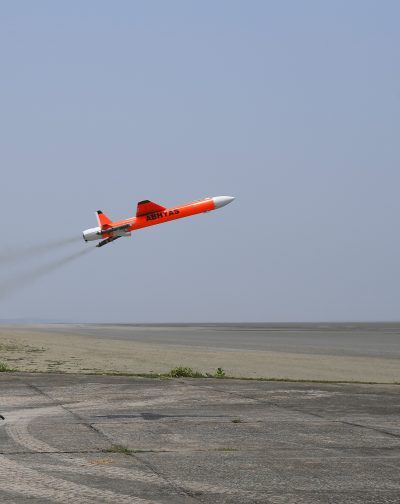Flight test of ABHYAS-HEAT 14/05/2019 – Posted in: Press Information Bureau
Flight test of ABHYAS-HEAT
(Ministry of Defence)
WHAT
Defence Research and Development Organisation (DRDO) conducted successful flight test of ABHYAS – High-speed Expendable Aerial Target (HEAT) from Interim Test Range, Chandipur in Odisha.
- ‘Abhyas’ is designed for autonomous flying with the help of an autopilot.
- The flight test was tracked by various RADARS & Electro Optic Systems and proved its performance in fully autonomous way point navigation mode.
- The configuration of ABHYAS is designed on an in-line small gas turbine engine and uses indigenously developed MEMS based navigation system for its navigation and guidance.
- A Luneburg lens in the nose cone improves the radar cross-section of the target for weapons practice. It also has an acoustic miss distance indicator (AMDI) to indicate the missed distance.
- The performance of the system was as per simulations carried out and demonstrated the capability of ABHYAS to meet the mission requirement for a cost effective HEAT.
DEVELOPMENT
DRDO Abhyas is a high-speed expendable aerial target (HEAT) being built by the Aeronautical Development Establishment (ADE) of the Defence Research and Development Organisation (DRDO) for the Indian Armed Forces.
FLIGHT PROFILE
The Abhyas is launched from a mobile launcher with the help of two 68 mm booster rockets (being manufactured at ordinance factories). At the end of its launch phase the burnout booster rockets are jettisoned. Thereafter, the main gas-turbine engine powers the vehicle during cruise phase.
|
OTHER RELATED INVENTIONS
DRDO Ulka
DRDO Lakshya
DRDO FluffyThe DRDO Fluffy was a target drone designed and developed by the Defence Research and Development Organisation’s Aeronautical Development Establishment (ADE) in Bangalore in early 1970s for use by the Indian Armed Forces. It had a maximum endurance of 5 minutes and could be launched from the maximum altitude of 30,000 feet. After the development of the reusable Aerial Target DRDO Lakshya, which was simpler and more economical to use than Fluffy, the production of the latter was discontinued. |
Source: PIB
You can follow us on LinkedIn and on Instagram (Diligent IAS) for more updates related to IAS Preparation/ Study Material, Subscribe to our Facebook Page and Youtube Channel- Diligent IAS
Also read more PIB Updates

